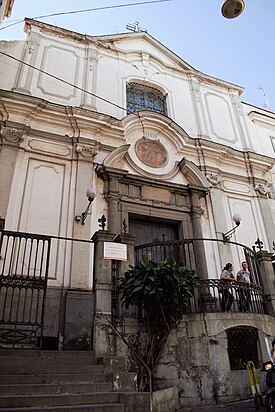Santa Maria ad Ogni Bene dei Sette Dolori
| Santa Maria ad Ogni Bene dei Sette Dolori | |
|---|---|
| Patronage : | Maria |
| Rank: | Basilica minor |
| Order : | Servites |
Coordinates: 40 ° 30 ′ 15.1 ″ N , 14 ° 8 ′ 39.2 ″ E
Santa Maria ad Ogni Bene dei Sette Dolori ("Santa Maria of all graces of the seven sorrows ") is the name of a church in Naples . It is located on a hill at a point from which you have a unique view of Spaccanapoli ; the place is therefore also known as the Belvedere ("beautiful view").
History and architecture
The origin of the building goes back to the year 1411, when a small rural chapel was built in front of the city walls , which was named Santa Maria ad Ogni Bene after the Madonna figure venerated there .
In 1516 a Servite convent was built next to it , which was enlarged and partly rebuilt towards the end of the century by the confrere and architect Giovanni Vincenzo Casali (* 1539 in Florence - † December 21, 1593 in Coimbra ). In the same year 1683 the Congrega del Crocifisso ("Congregation of the Cross") was established. As a result , a congregation was founded in the church, which was now called Santa Maria dei Sette Dolori , which later became the home of the Pii Operai after it was abandoned by the Servite monks .
The Pii Operai remained in the convent for 33 years - until 1630, when the nobleman Francesco Magnocavallo founded a brand new church of Santa Maria Ognibene elsewhere. At the same time, the Servites returned to their original church.
In 1640 an extension was made according to plans by the engineer Giovanni Cola Cocco . Other renovations took place in the first third of the 18th century with work on the sacristy (1703) and the chapel of the Duchess of Maddaloni , which was decorated with polychrome marble and stucco (1706). Finally, the whole church was redesigned from 1731 to 1735 by Nicola Tagliacozzi Canale in the late Baroque style . This was followed in 1735 by Antonio Saggese building the stairs and designing the Cappella di Sant'Alberto with an altar by Antonio Basso and statues by Domenico Antonio Vaccaro . In 1752 a new floor made of Maiolica tiles was laid.
The famous composer Giovanni Battista Pergolesi became the church's conductor in 1732.
In the early 19th century the monastery was abandoned and the Servites expelled; they took the figure of Mater dolorosa , venerated here, with them. When Naples was hit by a cholera epidemic in 1836, the community bought back the statue and, from 1837, placed it on the high altar.
With the reinstatement of the community in 1849, the church was replaced by Pope Pius IX. elevated to a minor basilica .
At the end of the 20th century apartments were set up in the monastery building. The church suffered damage from the Irpinia earthquake in 1980 , which has not yet been repaired to this day (as of 2018). The cloister of the monastery with three arcades on two floors on all sides is damaged. More recently, two church windows have also been bricked up on the right side.
The church
A staircase made of piperno rises in front of the two-storey facade of the church ; the portal dates from the end of the 16th century.
The interior is pale yellow and white and consists of a rectangular nave with an apse and dome ; there are five side chapels on either side, the arches of which are unusual in shape and decorated with stucco, as is the vaulted ceiling.
The marble main altar from the 18th century stands out due to its unusual architecture, with two side stairs that lead to the middle niche with a Madonna figure; this is attributed to Giacomo Colombo . In the church there are paintings by Fabrizio Santafede , Filippo Vitale , Paolo Finoglio , Giacomo del Pò , Paolo De Matteis , Domenico Antonio Vaccaro , Nicola Maria Rossi , Carlo Malinconico , Francesco Saverio Altamura and other unknown artists. In the sacristy remains of a fresco decoration and a marble washbasin with maiolica decoration by Ignazio Giustiniani (attributed) have been preserved.
In 1678 the famous sculptor and architect Cosimo Fanzago was buried in the church, but there are supposed to be some doubts as to whether his remains are actually located here.
Next to the church is the Oratorio della Confraternita del Santissimo Crocifisso ai Sette Dolori , which can be reached via the third chapel on the left, or through an independent entrance in the alley Vico della Congregazione dei Sette Dolori. Some valuable works of art are also kept inside, such as the erection of the cross by Michele Ragolia on the main altar.
literature
- Gennaro Aspreno Galante: Guida Sacra della citta di Napoli , 1873, pp. 365-366 (Italian).
- AA. VV .: Napoli: Montecalvario questione aperta , Clean edizioni, Naples (Italian).
- Vincenzo Regina: Le chiese di Napoli. Viaggio indimenticabile attraverso la storia artistica, architettonica, letteraria, civile e spirituale della Napoli sacra , Rome, Newton Compton, 2004. ISBN 88-541-0117-6 (Italian).
See also
Web links
Individual evidence
- ↑ Gennaro Aspreno Galante: Guida Sacra della citta di Napoli , 1873, pp. 365–366, here: 366.



